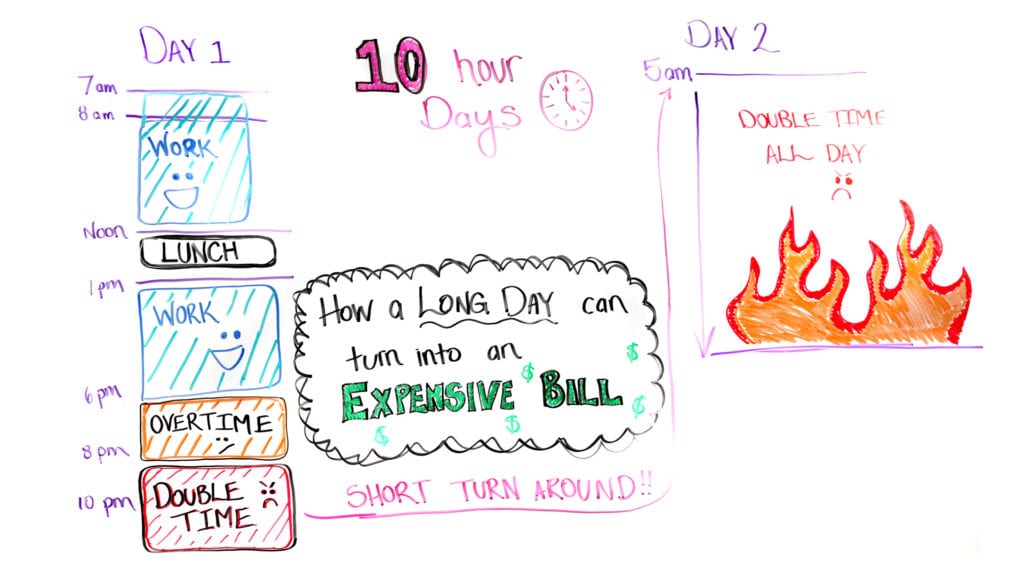Hiring an AV company for your event isn’t all fun and games, especially when AV labor comes into the equation. Truth is when you’re going through the process of finding an AV company, labor isn’t something that pops into mind. Well, at least not immediately. Sure, you know you’ll need all that equipment, and screens, and speakers, the works! But have you considered these things need to be operated by someone?
That’s the thing with AV labor. When you’re hiring, you’re not just hiring for equipment, you’re hiring for talent! And if you fail on carefully planning your event, the bill for the labor involved can easily turn into a huge expense. Today’s White Wednesday will tackle how a long day can turn into an expensive bill. Join Will Curran as he walks you through the best tips on how to schedule your event so that the AV labor doesn’t turn out to be more than you signed up for!
Are you planning an event? Check out our free Event Planning Checklist and be on your way to planning your best event yet!
Video Transcription – How A Long Day Can Turn Into An Expensive Bill
What’s going on, Endless fans? Will Curran from Endless Events back here again for another Whiteboard Wednesday, and today we’re talking about how a long day can turn into an expensive bill, especially an expensive AV labor bill. We really wanted to talk about this, because there’s a couple of rules that we get clarification and a lot of questions, and you know what? Figured it could use its own video as well.
All About AV Labor & Scheduling
We want to talk about when it comes to labor, is everything usually revolves around a day. A day is about 10 hours of work. A half day, half of that: five hours of work. Obviously, this depends on company to company. Sometimes you’ll hear a full day being eight hours, sometimes it’ll be four hours. When I talk about some of these rules, these are the ways that Endless has it set up. Every company’s going to be totally different in how it charges and how it follows these rules. But what we’ve found across the entire world, is that most companies follow these rules pretty straightforwardly, and usually when it comes down to it, the best companies usually all have about the same rules because they want to protect their employees in the same way.
Something to keep in mind as you go through this: these are just a couple of rules when you’re planning out your event and planning out your schedule. So keep in mind when you’re planning out your schedule in where you put breaks and things like that; this can majorly affect the AV company across the entire board.
The Beginning – Keep It Simple
The way to keep in mind as you’re thinking about it, is actually let’s plan on having this day start about eight, or about seven a.m., actually. Instead of eight a.m., we’ll have it start around seven a.m. The reason why is just to keep this really simple with numbers. After about five hours, you end up at about noon when it comes down to it.
Break Talk
The reason why I have it set up this way starting at seven a.m. and ending about noon for lunch is that after about five hours of work, most AV labor and most technicians and engineers are going to need a break. There’s sometimes a little smaller breaks, 15 minutes break, placed inside there for them to go grab their coffee, but usually what’s called … We’ll call it the lunch break … is that after about five hours, they’re going to need a lunch break or a meal break.
What If This Is In The Middle Of My Event?
This is why you want to set up your schedule to match this as best possible. When it comes down to it, after five hours you’re going to need a break. The break has to happen in either of two ways. First is that there’s called a walk away break, or what we’ll say is a one hour walk away lunch. This means for a solid hour, they need the ability to leave site, go grab lunch, relax, do whatever they want to do for that hour. You can’t dictate where they go. They can’t tell them to work on schedules. They have to be able to get a clean breakaway for an hour.
My best recommendation is to try scheduling a one hour break in the middle for them to get food, take a break, essentially.
The other option is a lot of companies will also do what’s called a 30-minute lunch provided break. So what this means is that they get 30 minutes to break. However, food has to be provided for them. So basically the idea is that you’re saving some time, that extra 30 minutes. Instead of them having to go find food, get their lunch, set up, whatever it is, it’s only 30 minutes.
But in this case, I’m going to do this being an hour break. Again, it gives the ability for you to extend into work a little bit later in the day which we’ll get to in just a little bit.
So again, two options when it comes to these meal breaks: one hour walk away, or a 30 minute provided lunch. Everybody with me so far? After five hours, give them that break.
More Break Talk (& Food!)
Then let’s say they come back, and they’re ready to get work done again. Well, then you get another five hours’ worth of work before you’re going to need another meal break. So again, after every five hours, feed ’em. Pretty simple, right? We want to feed people; we all have to eat at some point.
After about five hours, boom! You’re going to want to do another break as well. However, to illustrate this in the best way possible, I’m going to show you what happens a lot of times. Let’s say the general session starts at eight a.m., but seven a.m. is … From eight a.m. is a rehearsal, then you have a general session all day long and then let’s say we give ’em a lunch break because our general session’s not going to be in action during that time. Then we go back to doing general sessions. And it’s like a long day; we have a lot of meetings. But we then are going to have a late night gala dinner. There’s a party, whatever it may be. So we’re going to need ’em to stay past six p.m., which again is five hours after this.
OT, OT…
Well, then not only in addition to needing another meal break, but you also run into what is usually the dreaded overtime. And everyone wants to avoid this as much as possible, so this is how we’re going to recommend that you avoid this. For our company, we do it that after 10 hours, anything from 10 hours to 12 hours basically in that next section, is what’s called overtime. Overtime is one and a half times rate. Let’s say this normal person’s working for $50 an hour. Well at this point, when they’re working for these two hours from six p.m. to eight p.m., it’s in overtime, so they’re getting paid $75 an hour. You can see how this can get really expensive very, very fast.
How Endless Does AV Labor
At our company, we do it after 12 hours of straight work. Anything 12 hours, 13 hours, 14 hours…God forbid it goes any longer … it goes into what’s called double time. And this is the progression, right? You get the kind of happy work, and people like to say, “Why wouldn’t people want this? They just want overtime.” To be honest, if you talk to most engineers, they do not want to go to overtime and double time, because this means it’s a really long day of work. It means they’re … really, it’s getting into late nights. You’re talking about working till nine p.m., 10 p.m., oh my gosh, after they’ve been here since seven a.m. No one really wants to work double time.
You’ll Be Able To Tell
So you’re going from this kind of happy work, happy work … Well, then things start to get a little fuzzy when you get to this over time, and the warning signs should be blinking. At this point, if you don’t have this scheduled, and this is starting to happen, hopefully, your AV company will warn you and say, “Hey, just so you know, we’re about to go into overtime. We don’t want to do that.” They’ll hopefully warn you, but absolutely the thing you want to avoid is double time. That is just the worst, and that can be extremely dangerous because you’re then paying double the rate. You’ve gone from paying $50 an hour to paying $100 an hour. You can see how this can start to increase your bills and everything like that.
Schedule it Right!
When you’re planning out your schedule, you want to make sure that you’re giving these breaks along the way, but also that you don’t plan for these really long days. To be honest, just try to always plan around the engineer working for 10 hours total, with a one hour break. So, from 11 a.m. to six p.m., just be done. That’s a pretty simple way to avoid it.
However, some cases, we either have a long gala dinner or let’s say, for example, you need them to stay late for rehearsals, that’s when it makes sense … just plan for it when it comes. Again, all these rules kind of slightly differ between companies. So make sure that you’re talking to your AV company about what these rules are before you sign the quote, and that you understand them, because in the case you do have to take it as an emergency, avoid it. Right?
Beware Of The Short Turnaround
Another labor rule we get a lot of questions about is that what happens if let’s say, for example, you did all of this, and then you pushed and worked until let’s say 11 p.m. This double time went to 11 p.m., and you’re working till 11 p.m. Well, then you want to avoid something called a tight turnaround. And what this has to do, is let’s fast forward and whooop! Go to tomorrow. Let’s say this was the first day, but the next day, you have an early morning breakfast with the CEO, that starts at six a.m., so you need all the engineers there at five a.m. Short turnaround is what happens whenever the engineers have to finish one, a work session or work shift, and in less than eight hours between when they end work and when they start work, it’s called a short turnaround.
What To Do?
What this means is always when you’re planning your schedule, plan for when the engineers finish their work, you have at least eight hours between when they start their next shift. The reason why you want to avoid this is when you get into the eternal horrible day of flames and extremely high costs. The reason why is anything that happens then that next day can lead to pretty much double time all day long. Again, these rules slightly depend on the company, but what I’ve seen is that the next day it starts, they immediately start on overtime.
The Overtime Rollercoaster Of AV Labor
What that means is anything that day is going to be already in overtime. If you end up doing this again, where you go into overtime, it’s overtime of overtime. So you’re going 1.5 costs, times 1.5 costs. Then God forbid, you go to the double time, and it’s 1.5 costs times two times costs. You can see how this day could be extremely expensive. And the most common way that we see this happen is when you have a long gala dinner, and then you have to be out of the venue and everything has to be torn down the next morning, early morning, because you have to be out by noon, for example. You want to manufacture your schedule so then that way again, you cause a nice big eight-hour break between the two days.
Up And Running!
What’s nice, is that I find with most AV companies, if, for example, the guys end at 11 p.m., and then the next day would obviously be seven a.m. would be the start time. They don’t factor in things like driving, but that’s something to keep in mind with your AV engineers; a lot of them are not going to be at the hotel right across the street. Sometimes they’ll be … for example, having to drive an hour to go get home. Obviously, that’s the engineer’s choice in where they live and things like that, but that’s something to keep in mind. We want everyone to get a full eight hours of sleep, but if you keep in mind factoring drive time and everything like that, it can lead to really horrible times where you’re driving for an hour to get home. You only sleep for five hours because you have to be up in the morning and then be there on time.
Avoidance
Some ways that I’ve seen avoiding short turnarounds, and some more forgiveness around it, is that if you know you have to do a short turnaround for some reason, providing hotels on site, so then that way, hey yeah, you’re going to be in short turnaround, but maybe we can avoid the short turnaround since we’re providing on-site to eliminate drive time and travel time and everything like that. We’ve seen that help as well.
The Recap On AV Labor
Again, just to recap, five-hour chunks. Make sure you get meal breaks. Make sure … Otherwise, you’re going to get into meal break. There are some penalties related to meal breaks, which are related sometimes to overtime where if you don’t give a meal break, things can be forced into overtime earlier, that sort of stuff. But after 10 hours, avoid overtime. After 12 hours-ish, avoid the double time and then make sure you give a nice eight-hour break in between your different days and shifts because then you can get into this horrible day of flames, which I’ll call short turnaround all day.
Conclusion
I hope you found this helpful. If you did, I would love for you to subscribe down below. If you really loved it, give it a thumbs up. However, if you didn’t like it, give us a thumbs down. And down in the comments, let us know how we can make this event better. Also, we want to hear from you: what sort of topics do you want us to cover? Leave a comment down below and let us know what sort of topics you want us to cover, what sort of scenarios you’ve seen.
The prompt that I have for you today is what’s an example of an event where you had one of these rules broken, and how did it affect your event? Did you have any clever ways for ways that you avoided it? Do you have any tips for other planners for how you schedule out your schedules to avoid things like meal break penalties and overtime and everything like that? What’s your take no AV labor in general? We’d love to hear it down in the comments below!
That’s going to do it for this week’s Whiteboard Wednesday. Thank you, everybody, for tuning in, and we can’t wait to see you next week. I’ll catch you later, Endless fans!
Resources:
-
What Do All The AV Labor Positions Do – Whiteboard Wednesday
-
Learn About Event Safety and Cybersecurity, Event Labor Costing, and More
 hbspt.cta.load(430132, ‘f5d4b0f9-3c68-485b-bc07-c33652f8011a’, {});
hbspt.cta.load(430132, ‘f5d4b0f9-3c68-485b-bc07-c33652f8011a’, {});









